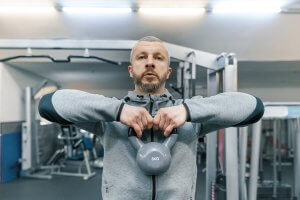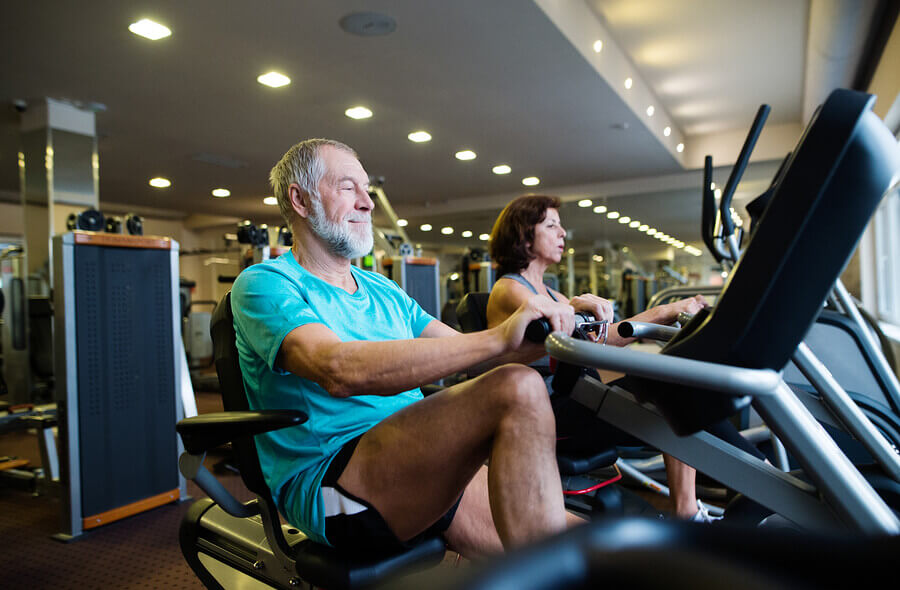How to Build Muscle after 40

The human body has its complexities and learning to keep it healthy is not an easy task. It’s true that physical prime is usually reached between the age of 20 and 30 years. So the question arises, how can people maintain or build muscle mass after forty?
Thirty seems to be the limit of a person’s physical prime, after 30, the formation of muscle mass begins to slow down. However, this only happens with people who do little physical activity or those who lead a sedentary lifestyle.
Let’s move and build muscle!
In today’s world, sedentary lifestyles are more common. Keep in mind that unhealthy physical and eating habits are not compatible with maintaining or gaining muscle mass after the age of 40.
Although it’s not an easy task, muscle mass can be developed after 40. It’s important to know your own body and to adopt healthy lifestyles. You can obtain your goals by performing certain routines and following personalized diets. These elements will have an impact on your metabolism and muscle growth.
Gaining muscle after the age of 40
Aging is a natural process and it brings its own challenges. Aging is not always negative, many athletes, actors, and celebrities actually improve their physical conditions and become more attractive as they age.

However, most people don’t dedicate themselves to taking care of their bodies. The main challenges are taking the first step.
It’s harder to gain muscle after 40 and that’s an irreversible fact. However, if you’re consistent in your diet and work hard, you’ll be able to ‘rejuvenate’ your body.
Another physical element to consider is the health of your joints and tendons. Over the years, joints and tendons tend to deteriorate. When you start exercising, it’s important to progress gradually.
Building muscle: diet is key
Food is the key to development and helps to build muscle. A healthy diet provides all of the nutrients that the body needs for muscle formation. It also allows the body to complete all of the complex movements that are required while exercising.
At 40, it’s important to have a diet that’s rich in antioxidants, natural fibers, and unsaturated fats. In addition to helping you gain muscle mass, a healthy diet will also prevent liver disease. Protein-rich foods are vital as they help prevent the deterioration of muscle mass.
Yes to carbohydrates
Carbohydrates are also necessary since they fuel the body. They occupy an important role in the production of glucose which fuels the brain.
A common mistake is to believe that carbohydrates should be avoided if you are trying to gain muscle tone. However, that isn’t true.
Some specialists recommend ingesting 2,500 calories daily, although this figure varies according to the individual-specific characteristics. When creating a healthy eating regimen, it’s wise to consult a nutritionist who will give you personalized advice.

Exercises to build muscle after 40
The human body is impressive and physical activity is necessary in order to maintain it that way. As we previously mentioned, after the age of 30, physical deterioration begins; therefore, exercise becomes a bit more complex.
Gaining muscle after 40 requires certain physical conditions. This doesn’t mean you should exercise less, it simply means you need to be more strategic in order to avoid serious injuries.
Experts recommended stretching before exercising. Afterward, continue with lighter weights and carry out more repetitions in order to stimulate muscle growth.
Eccentric exercises are another great way to build muscle mass as long as they’re not abused. It’s important to rest sufficiently. Believe it or not, rest will also help you reach your goal. In order to increase muscle mass after 40, it’s important to reach a balance between diet, physical activity and rest.
The human body has its complexities and learning to keep it healthy is not an easy task. It’s true that physical prime is usually reached between the age of 20 and 30 years. So the question arises, how can people maintain or build muscle mass after forty?
Thirty seems to be the limit of a person’s physical prime, after 30, the formation of muscle mass begins to slow down. However, this only happens with people who do little physical activity or those who lead a sedentary lifestyle.
Let’s move and build muscle!
In today’s world, sedentary lifestyles are more common. Keep in mind that unhealthy physical and eating habits are not compatible with maintaining or gaining muscle mass after the age of 40.
Although it’s not an easy task, muscle mass can be developed after 40. It’s important to know your own body and to adopt healthy lifestyles. You can obtain your goals by performing certain routines and following personalized diets. These elements will have an impact on your metabolism and muscle growth.
Gaining muscle after the age of 40
Aging is a natural process and it brings its own challenges. Aging is not always negative, many athletes, actors, and celebrities actually improve their physical conditions and become more attractive as they age.

However, most people don’t dedicate themselves to taking care of their bodies. The main challenges are taking the first step.
It’s harder to gain muscle after 40 and that’s an irreversible fact. However, if you’re consistent in your diet and work hard, you’ll be able to ‘rejuvenate’ your body.
Another physical element to consider is the health of your joints and tendons. Over the years, joints and tendons tend to deteriorate. When you start exercising, it’s important to progress gradually.
Building muscle: diet is key
Food is the key to development and helps to build muscle. A healthy diet provides all of the nutrients that the body needs for muscle formation. It also allows the body to complete all of the complex movements that are required while exercising.
At 40, it’s important to have a diet that’s rich in antioxidants, natural fibers, and unsaturated fats. In addition to helping you gain muscle mass, a healthy diet will also prevent liver disease. Protein-rich foods are vital as they help prevent the deterioration of muscle mass.
Yes to carbohydrates
Carbohydrates are also necessary since they fuel the body. They occupy an important role in the production of glucose which fuels the brain.
A common mistake is to believe that carbohydrates should be avoided if you are trying to gain muscle tone. However, that isn’t true.
Some specialists recommend ingesting 2,500 calories daily, although this figure varies according to the individual-specific characteristics. When creating a healthy eating regimen, it’s wise to consult a nutritionist who will give you personalized advice.

Exercises to build muscle after 40
The human body is impressive and physical activity is necessary in order to maintain it that way. As we previously mentioned, after the age of 30, physical deterioration begins; therefore, exercise becomes a bit more complex.
Gaining muscle after 40 requires certain physical conditions. This doesn’t mean you should exercise less, it simply means you need to be more strategic in order to avoid serious injuries.
Experts recommended stretching before exercising. Afterward, continue with lighter weights and carry out more repetitions in order to stimulate muscle growth.
Eccentric exercises are another great way to build muscle mass as long as they’re not abused. It’s important to rest sufficiently. Believe it or not, rest will also help you reach your goal. In order to increase muscle mass after 40, it’s important to reach a balance between diet, physical activity and rest.
All cited sources were thoroughly reviewed by our team to ensure their quality, reliability, currency, and validity. The bibliography of this article was considered reliable and of academic or scientific accuracy.
- Dirección Gral de la Mujer. Comunidad de Madrid. Guía de la actividad física y la mujer a cualquier edad. Extraído de: http://www.madrid.org/bvirtual/BVCM014011.pdf
- Congreso Internacional Educación Física. 2004. Extraído de: https://www.um.es/univefd/presmus.pdf
- Colegio Oficial de Psicología. Manual de ejercicios de psicología positiva aplicada. Extraído de: https://www.cop-cv.org/db/docu/170419111407WtnYiyZunKZr.pdf
This text is provided for informational purposes only and does not replace consultation with a professional. If in doubt, consult your specialist.








